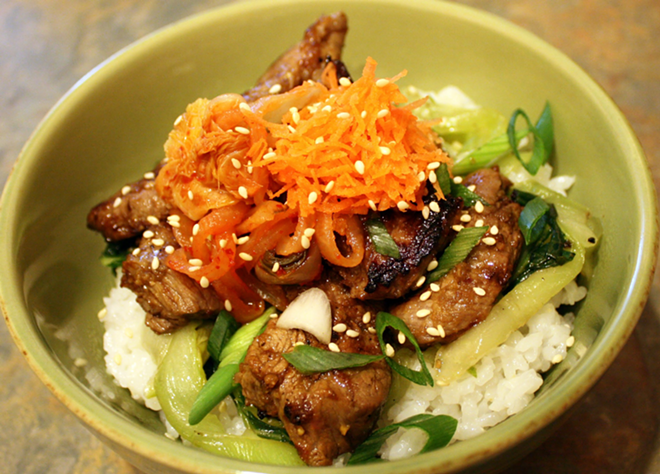Being that I’m always experimenting with food, I’ve been on a Korean kick lately. Korea's food obviously has some similar elements to Chinese and Japanese dishes, but as a whole it's nowhere near the same. Japanese food seems to be more on the minimalist side of things — with simple, clean flavors — while Chinese cooking (in most regions) uses many ingredients and flavors. Korean cooking lies somewhere in the middle.
Korean cuisine is based on vegetables, meat and rice, and often includes garlic, ginger, pepper flakes, sesame oil, black pepper, vinegars, doenjang (fermented bean paste) and gochujang (fermented red chili paste) — yielding an array of tangy, savory and sometimes spicy dishes.
For my experiment, I took inspiration from two popular Korean dishes: bulgogi and bibimbap. Bulgogi is traditionally thinly sliced beef sirloin that has been marinated in a mixture of soy sauce, sugar, sesame oil, garlic and other ingredients. It is then quickly grilled or stir-fried and served with lettuce (to wrap the meat in) and a dipping sauce.
Bibimbap is a staple of Korean cooking comprised of a bowl filled with rice and topped with meat, usually beef, gochujang, varying combinations of vegetables and a fried egg. The contents in the bowl are typically mixed together while being eaten, which is very fitting as the word bibimbap in Korean literally translates to “mixed meal."
Put the two dishes together and you get this Korean barbecue beef and rice bowl with bok choy. (See recipe below.) I didn’t have any gochujang on hand, so I substituted red pepper flakes in the marinade. As for the beef, I used the flat iron cut, which is a thinner piece of meat cut from the shoulder section, similar to skirt or flank steak. Flat iron, or “top blade,” steak is a tender, flavorful and inexpensive cut that takes well to marinating and should be cooked quickly over fairly high heat. Don't go much past medium or it will become tough.
Korean barbecue beef and rice bowl with bok choy
Makes 2 servings
Ingredients:
Beef:
1 pound beef flank, flat iron or skirt steak
2 tablespoons canola or vegetable oil
Marinade:
1/2 white or yellow onion, chopped
1/2 Asian or Bosc pear
3 cloves garlic, chopped
1-inch fresh ginger, chopped
2 tablespoons honey
2 tablespoons brown sugar
1/2 cup soy sauce (preferably low-sodium)
1/2 cup Mirin (rice wine)
1 tablespoon sesame oil
1/2 teaspoon red pepper flakes
Bok Choy:
1 tablespoon canola or vegetable oil
1 head of baby bok choy
1/2 cup water
Bowl:
1 cup short-grain (sushi) rice, prepared
1 carrot, grated
1/2 cup prepared Kimchi (fermented Napa cabbage and vegetables — tastes better than it sounds)
2 scallions, sliced
2 tablespoons toasted sesame seeds
2 teaspoons sesame oil
Directions:
1. Clean off all fat from beef and slice 1/4-inch thick. Mix marinade ingredients together in a large bowl. Place sliced beef in the marinade, cover and refrigerate two hours to overnight.
2. Prepare rice to package directions. Remove beef pieces from marinade and pat dry, reserving marinade. Heat a grill, cast iron pan or grill pan to high heat and add oil. Cook beef about 1-2 minutes per side, getting a nice sear on both sides. Place cooked meat on a plate and cover with aluminum foil until serving.
3. While beef is cooking, add reserved marinade to a small saucepan and add a half-cup of water. Bring to a boil then reduce to medium heat and let it simmer and reduce.
4. For the bok choy, heat a sauté pan to medium high heat and add oil. Quickly sear the bok choy until it just starts to brown, then add water and turn down heat to medium. Let it cook until the bok choy is tender and the water has evaporated (adding more water if needed).
5. Scoop cooked rice into bowls and top with beef, bok choy, grated carrot and kimchi. Spoon marinade sauce over it and sprinkle scallions and sesame seeds on top. Drizzle with sesame oil and serve hot.


